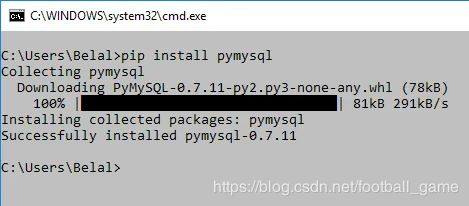Python MySQL教程:将MySQL数据库与Python结合使用
什么是PyMySQL
您可能已经知道要使用任何数据库,我们需要数据库驱动程序。PyMySQL是用于在Python中运行MySQL的纯Python驱动程序。
现在,请记住,默认情况下此PyMySQL不可用。因此,首先,我们将学习如何下载和安装此驱动程序。
安装PyMySQL
在这里,我假设您的计算机上已经安装了python。而且,您已经完成了设置环境变量的工作。如果没有,那么您应该先转到此链接。
要安装PyMySQL,请运行以下命令(对于Linux的MAC使用终端,我正在使用Windows,因此我正在使用cmd)。
pip install pymysql
现在,一旦我们安装了PyMySQL,就可以从Python学习操作MySQL数据库。在此Python MySQL教程中,我将向您介绍使用Python在MySQL数据库中进行的基本CRUD操作。
注意:CRUD表示数据库中的创建,读取,更新和删除操作。
在MySQL中创建数据库
在开始任何操作之前,我们需要一个数据库,对吗?因此,打开您的MySQL数据库,对于MySQL,我在这里使用XAMPP,并且可以使用localhost / phpmyadmin访问它。
尽管您也可以使用任何其他软件,但过程将相同。
转到localhost / phpmyadmin 并创建一个数据库。我创建了一个名为belal的数据库,如下图所示。

现在,在数据库内部,我们将创建表。因此,转到SQL并运行以下SQL查询来创建表。
CREATE TABLE todos(
id INTEGER PRIMARY KEY AUTO_INCREMENT,
title VARCHAR(100),
desc VARCHAR(500),
date DATE
)
上面的查询将创建下表。

Python MySQL教程:执行基本CRUD
在这里,我正在使用PyCharm IDE。(我爱上了JetBrains IDEs)。
现在,让我们从PyCharm中的新Python项目开始。
创建操作
在您的项目中创建一个名为CreatTask.py的新Python文件。第一步是导入pymysql。
import pymysql
然后我们将连接到数据库。
connection = pymysql.connect(
host=‘localhost’,
user=‘root’,
password=‘password’,
db=‘belal’,
)
现在,我们将获得用户输入,因为我们需要在表中存储标题,描述和日期。因此,我们将从用户那里获得这些值。
title = input("Enter title of your task: ")
desc = input("Add some description to it: ")
date = input("Enter the date for this task (YYYY-MM-DD): ")
因此,我们具有值以及与MySQL数据库的连接。要插入值,我们这样做。
try:
with connection.cursor() as cursor:
sql = “INSERT INTO todos (title, desc, date) VALUES (%s, %s, %s)”
try:
cursor.execute(sql, (title, desc, date))
print(“Task added successfully”)
except:
print(“Oops! Something wrong”)
connection.commit()
finally:
connection.close()
我们拥有AddTask.py的最终代码是。
import pymysql
connection = pymysql.connect(
host=‘localhost’,
user=‘root’,
password=‘password’,
db=‘belal’,
)
title = input("Enter title of your task: ")
desc = input("Add some description to it: ")
date = input("Enter the date for this task (YYYY-MM-DD): ")
try:
with connection.cursor() as cursor:
sql = “INSERT INTO todos (title, desc, date) VALUES (%s, %s, %s)”
try:
cursor.execute(sql, (title, desc, date))
print(“Task added successfully”)
except:
print(“Oops! Something wrong”)
connection.commit()
finally:
connection.close()
如果获得如上所示的输出,则应该在MySQL数据库中看到这些值。

读取操作
再次创建一个名为ReadTasks.py的新Python文件,并在其中编写以下代码。
import pymysql
connection = pymysql.connect(
host=‘localhost’,
user=‘root’,
password=‘password’,
db=‘belal’,
)
try:
with connection.cursor() as cursor:
sql = “SELECT id, title, desc FROM todos WHERE date = CURDATE()”
try:
cursor.execute(sql)
result = cursor.fetchall()
print("Id\t\t Title\t\t\t\t\tDescription")
print("---------------------------------------------------------------------------")
for row in result:
print(str(row[0]) + "\t\t" + row[1] + "\t\t\t" + row[2])
except:
print("Oops! Something wrong")
connection.commit()
finally:
connection.close()
更新操作
我现在希望;您可以自己执行所有操作。但是,如果您有任何困惑,这里是用于更新MySQL数据库中的值的代码段。
try:
with connection.cursor() as cursor:
sql = “UPDATE todos SET title=%s, desc=%s WHERE id = %s”
try:
cursor.execute(sql, (‘your new title’, ‘your new description’, 1))
print(“Successfully Updated…”)
except:
print(“Oops! Something wrong”)
connection.commit()
finally:
connection.close()
删除操作
最后,您可以将记录删除为。
try:
with connection.cursor() as cursor:
sql = “DELETE FROM todos WHERE id = %s”
try:
cursor.execute(sql, (1,))
print(“Successfully Deleted…”)
except:
print(“Oops! Something wrong”)
connection.commit()
finally:
connection.close()
我们已经完成了MySQL中的所有CRUD操作。这就是Python MySQL教程朋友的全部内容。我希望您发现这样做对您有帮助,然后与正在学习python的朋友分享这篇文章。


